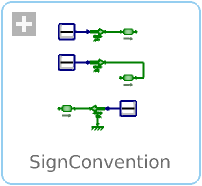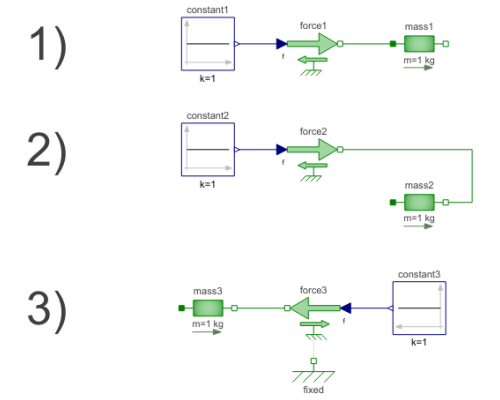WOLFRAM SYSTEM MODELER
SignConventionExamples for the used sign conventions |
|
Diagram
Wolfram Language

SystemModel["Modelica.Mechanics.Translational.Examples.SignConvention"]

Information
This information is part of the Modelica Standard Library maintained by the Modelica Association.
If all arrows point in the same direction, a positive force results in a positive acceleration a, velocity v and position s.
For a force of 1 N and a mass of 1 kg this leads to
a = 1 m/s2 v = 1 m/s after 1 s (SlidingMass1.v) s = 0.5 m after 1 s (SlidingMass1.s)
The acceleration is not available for plotting.
System 1) and 2) are equivalent. It doesn't matter whether the force pushes at flange_a in system 1 or pulls at flange_b in system 2.
It is of course possible to ignore the arrows and connect the models in an arbitrary way. But then it is hard see in what direction the force acts.
In the third system the two arrows are opposed which means that the force acts in the opposite direction (in the same direction as in the two other examples).
Components (10)
| mass1 |
Type: Mass Description: Sliding mass with inertia |
|
|---|---|---|
| force1 |
Type: Force Description: External force acting on a drive train element as input signal |
|
| constant1 |
Type: Constant Description: Generate constant signal of type Real |
|
| mass2 |
Type: Mass Description: Sliding mass with inertia |
|
| force2 |
Type: Force Description: External force acting on a drive train element as input signal |
|
| constant2 |
Type: Constant Description: Generate constant signal of type Real |
|
| mass3 |
Type: Mass Description: Sliding mass with inertia |
|
| force3 |
Type: Force Description: External force acting on a drive train element as input signal |
|
| constant3 |
Type: Constant Description: Generate constant signal of type Real |
|
| fixed |
Type: Fixed Description: Fixed flange |

